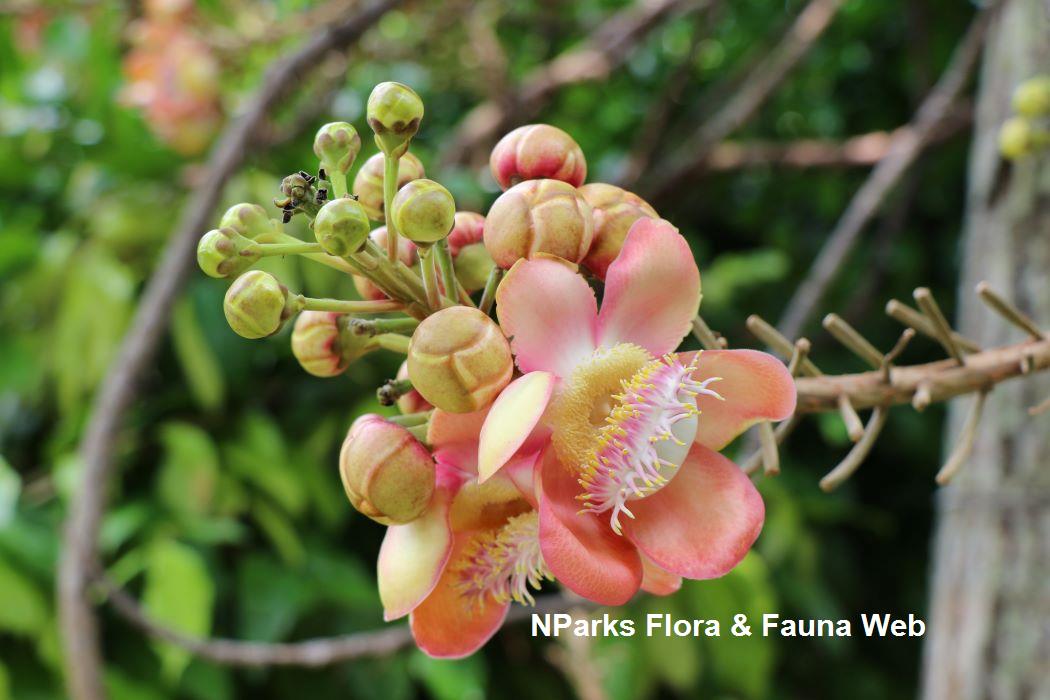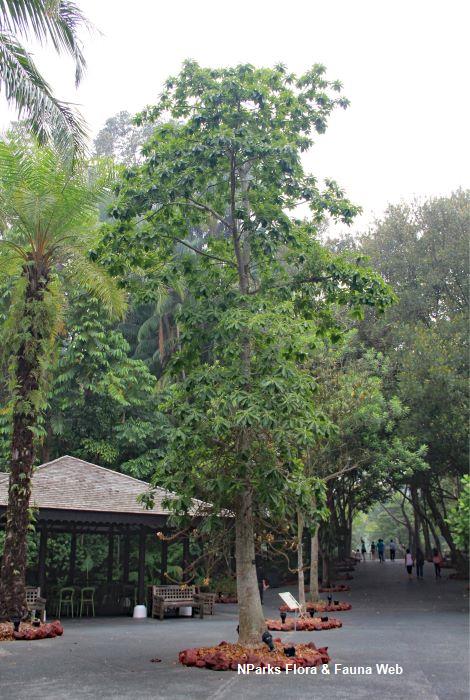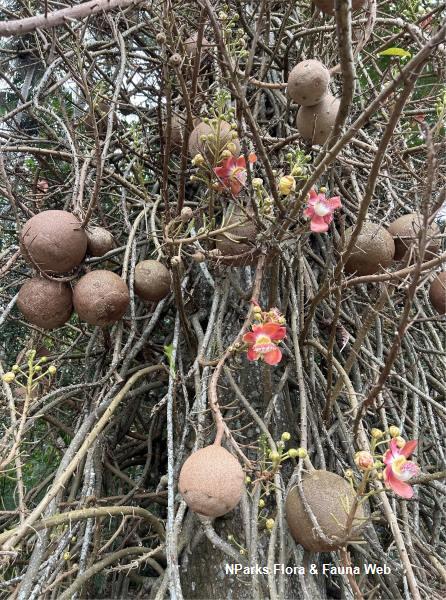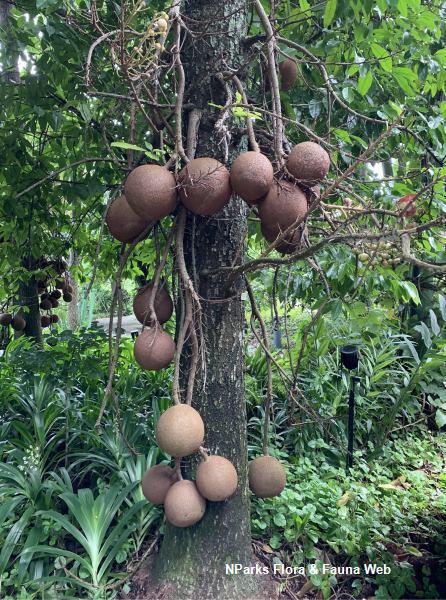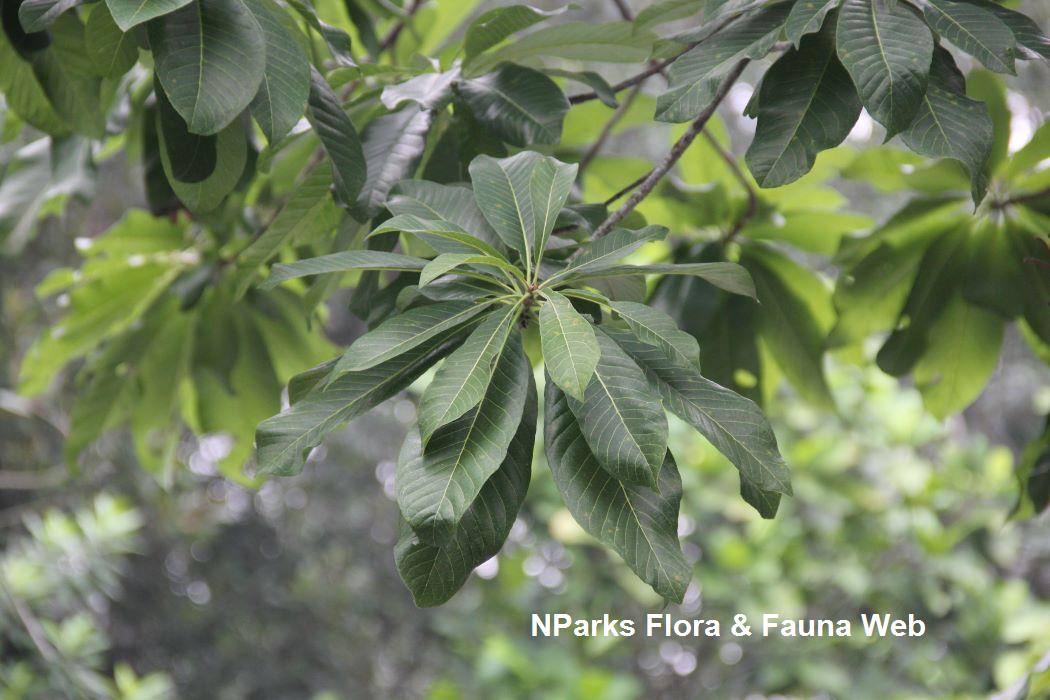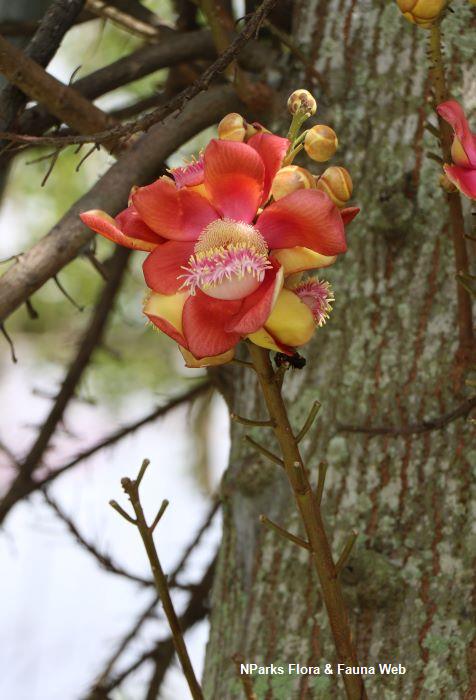
Back
Couroupita guianensis Aubl.
| Family Name: | Lecythidaceae |
| Common Name: | Cannon Ball Tree, Castanha-de-Macaco, Nagalingam, Buah Kanon, 炮弹树 |
Couroupita guianensis often known as Cannon Ball Tree produces fragrant inflorescences that last for a day. These inflorescences are borne on thick tangled branches produced from the trunk. At maturity, the fruit drops on the ground with a loud thud baring its seeds suspended in pulp. As opposed to the pleasant-smelling flowers, the fruits release a repugnant odour.
Name
Classifications and Characteristics
| Plant Division | Angiosperms (Flowering Seed Plants) (Dicotyledon) |
|---|---|
| Plant Growth Form | Tree |
| Lifespan (in Singapore) | Perennial |
| Mode of Nutrition | Autotrophic |
| Plant Shape | Oval |
| Maximum Height | 20 m to 35 m |
| Maximum Plant Spread / Crown Width | 9 m |
| Tree or Palm – Trunk Diameter | 0.8 m |
Biogeography
| Native Distribution | From Panama, French Guiana to Tropical South America. |
|---|---|
| Native Habitat | Terrestrial (Primary Rainforest) |
| Preferred Climate Zone | Tropical |
Description and Ethnobotany
| Growth Form | It is a tree, usually up to 25 m tall under cultivation. |
|---|---|
| Trunk | Up to 0.8m across, appearing more massive due to dense tangle of long dangling branchlets (up to 3m long) that emerge and cover lower trunk, especially in older trees. Bark greyish-brown, fissured. |
| Foliage | Leaves smooth to slightly velvety with serrate and somewhat margins, simple, arranged spirally at ends of branches. Species is semi-deciduous, shedding its leaves around once to twice a year, usually in response to dry weather. |
| Flowers | Complex nectarless structures, each consisting of 6 large and fleshy-waxy petals that are red to orange on the inside and yellow on the outside, a disk of numerous short and yellow ring-stamens (which produce fertile pollen) arranged around reduced styles and stamens, and a pink-white anemone-like structure of hood-stamens (which produce sterile pollen). Highly-fragrant, primarily pollinated by carpenter bees (Xylocopa spp.) and bats (which consume the anthers and stamens, besides the sterile pollen). Mainly cross-pollinated but experiments that it is able to self-pollinate. Species is cauliflorous -- flowers are produced in racemes along woody extrusions emerging directly from trunk or large branches further up the tree. Flowers last only 1 day, but several are produced at any one time throughout the year. |
| Fruit | Nuts large (20-24cm across), globose, with hard woody exocarp (shell), produced in clusters, taking some 18 months to attain maturity, and resembling rusty-brown cannonballs when ripe. Upper part of fruits crack open upon dropping to the ground, exposing 200-300 hairy seeds embedded in 6-segmented jelly-like pulp that oxidizes from white to bluish-green and emits an unpleasant fermented-like scent when exposed to air. |
| Habitat | It is found in tropical rainforests. |
| Cultivation | It is a fuss-free tree and prefers deep, moist and humus-rich soils. Provide regular water for optimal growth. It can be propagated by seeds from ripe fruits (although germination may be difficult), or woody stem cuttings. Handle with care, as flower pollen and fruit pulp may be allergenic or irritating to susceptible individuals. |
| Etymology | Genus epithet 'Couroupita' is the Latinized form of the French Guiana vernacular name, Kouroupitoumou. Species epithet guianensis means 'of or from French Guiana (Guyana)', a reference to the plant's native distribution. |
| Ethnobotanical Uses | Cultural / Religious:
Heritage Trees :
There are two individuals of Couroupita guianensis listed as Heritage Trees in Singapore. To find out more about these trees, please visit the Heritage Tree Register. Others: In India, it is commonly planted near Hindu temples and is regarded as a sacred tree by Hindus because the flowers resemble the Naga (hooded snake) of Lord Shiva. Flowers used in Hindu prayer, also used by Buddhist worshippers in Sri Lanka. |
Landscaping Features
| Desirable Plant Features | Ornamental Flowers, Ornamental Fruits, Fragrant |
|---|---|
| Landscape Uses | General, Focal Plant |
| Usage Hazard - Cons | Irritant - Contact Allergy, Large Heavy Fruits |
| Usage Hazard - Cons Remarks | Flower pollen and fruit pulp may cause irritation to some people. Fruits are large and fall without warning. |
Fauna, Pollination and Dispersal
| Pollination Method(s) | Biotic (Fauna) (Insects (Bee), Carpenter bees (Xylocopa spp.)) |
|---|---|
| Seed or Spore Dispersal | Biotic (Fauna) (Ripe fruits drop and crack open on ground. Seeds are eaten by animals.) |
Plant Care and Propagation
| Light Preference | Full Sun |
|---|---|
| Water Preference | Moderate Water |
| Plant Growth Rate | Moderate |
| Rootzone Tolerance | Fertile Loamy Soils, Well-Drained Soils |
| Propagation Method | Seed |
| Propagule Establishment Remarks | Seed germination may be difficult. |
| Maintenance Requirements Remarks | Massive trunk densely covered by long fruit-bearing twigs. Tree shoud not be planted too closely to roads or paths where clearance is needed. |
| Planting Distance | 6 m to 9 m |
Foliar
| Foliage Retention | Drought / Semi-Deciduous |
|---|---|
| Mature Foliage Colour(s) | Green |
| Foliar Type | Simple / Unifoliate |
| Foliar Arrangement Along Stem | Spiral |
| Foliar Shape(s) | Non-Palm Foliage (Elliptical) |
| Foliar Venation | Pinnate / Net |
| Foliar Margin | Entire - Wavy / Undulate |
| Foliar Apex - Tip | Acute |
| Foliar Base | Cuneate |
| Typical Foliar Area | Mesophyll ( 45cm2 - 182.25 cm2 ) |
| Leaf Area Index (LAI) for Green Plot Ratio | 3.0 (Tree - Intermediate Canopy) |
Non - Foliar and Storage
| Trunk Type (Non Palm) | Woody |
|---|---|
| Bark Colour(s) | Greyish-brown |
| Mature Bark Texture | Fissured |
| Stem Type & Modification | Woody |
| Root Type | Underground (Tap Root, Fibrous Root) |
Floral (Angiosperm)
| Flower & Plant Sexuality | Bisexual Flowers |
| Flower Colour(s) | Pink, Red, Yellow / Golden |
|---|---|
| Flower Size - Remarks | 6 - 10cm across |
| Inflorescence Type | Raceme |
| Flowering Period | Free-Flowering |
| Flower Lifespan on Plant | 1 Day |
| Flowering Habit | Polycarpic |
Fruit, Seed and Spore
| Mature Fruit Colour(s) | Brown |
|---|
Image Repository
Others
| Master ID | 1534 |
|---|---|
| Species ID | 2827 |
| Flora Disclaimer | The information in this website has been compiled from reliable sources, such as reference works on medicinal plants. It is not a substitute for medical advice or treatment and NParks does not purport to provide any medical advice. Readers should always consult his/her physician before using or consuming a plant for medicinal purposes. |


